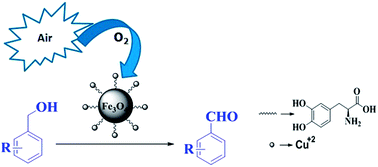Nanoparticle-supported and magnetically recoverable organic–inorganic hybrid copper(ii) nanocatalyst: a selective and sustainable oxidation protocol with a high turnover number†
Abstract
A magnetically recoverable copper-based nanocatalyst was prepared from inexpensive starting materials. With a particle size between 20 to 30 nm, it was shown to catalyze the oxidation of benzylic alcohols. The catalyst exhibited a high turnover number (TON) and excellent selectivity. The catalyst was characterized by several techniques, such as XRD, HR-TEM, SAED, EDS, FT-IR, VSM, and BET surface area. Factors affecting the reaction parameters, such as the substrate to oxidant molar ratio, weight of the catalyst, reaction time, etc., were investigated in detail. The reusability of the catalyst was examined by conducting repeat experiments with the same catalyst; it was observed that the catalyst displayed no significant changes in its activity even after seven cycles for the aerobic, as well as for the peroxide, oxidation of benzyl alcohol. Furthermore, the heterogeneous nature, easy recovery, and reusability, makes the present protocol highly beneficial for addressing environmental concerns and industrial requirements.


 Please wait while we load your content...
Please wait while we load your content...